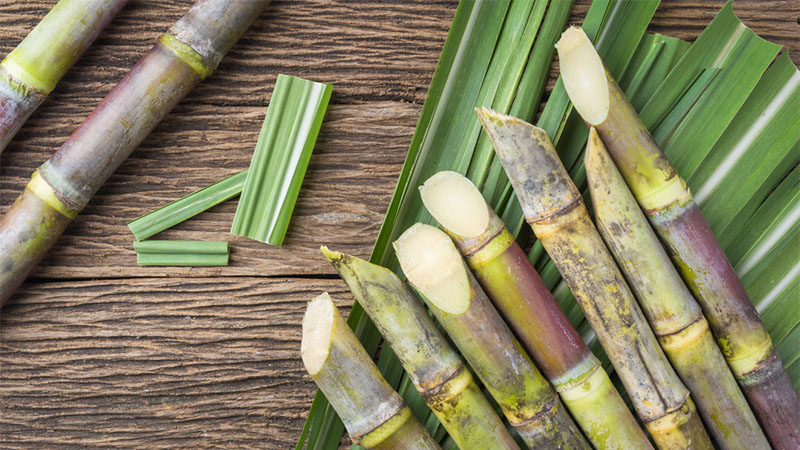We foraged for exciting Asian ingredients that are readily available in Hong Kong to discover their traditional uses, health benefits and ways to incorporate them into Western home cooking. Here, we find out more about cooking with sugarcane.
Sugarcane – What is it?
Sugarcane is a tall, tropical, perennial grass that grows up to five metres high. The stems, the main bulk of the plant, are the cane stalks that are harvested and processed to make cane sugar and other products.

The flavour
Sugarcane stalks, though woody, release a deliciously sweet, pale, yellowy-green juice.
Where to find it
At wet markets. To see it growing, visit the leisure farms at Fanling in the New Territories. It is also available canned in some countries where you can’t buy it fresh.
Uses
- The original candy, raw sugarcane stalks are chewed on as a sweet snack in many developing countries.
- Throughout Southeast Asia and India, the juice is extracted by running the cane through small mills.
- To make sweeteners: sugar, syrup, (in the US, the cheaper alternative, high fructose corn syrup, is now used instead), molasses and jaggery.
- To make the alcoholic spirit cachaça in Brazil, which is the star ingredient in the national cocktail caipirinha.
- To make rum (often from molasses) in the Caribbean.
- The ethanol made from sugarcane is used both for transportation and as a green alternative to petroleum in the making of plastic.
- The pulp and stalks are used for woven furniture, cardboard and paper products.
 Health benefits
Health benefits
- Sugarcane is a source of iron, B vitamins, calcium, magnesium, phosphorus and potassium.
- Nutrient-dense blackstrap molasses, a by-product, treats anaemia by promoting red blood cell production.
- Sugarcane’s antioxidants can prevent and repair damage by free radicals, and may also fight infection and disease.
- Raw sugarcane’s low glycaemic index keeps blood sugar levels more stable than processed sugar would do, making it a better choice for diabetics.
Cook it at home
Here, sugar cane stalks serve as a great presentation skewer for the prawn paste as well as lending a sweet finish to the dish. The delicate flavours of Vietnamese chao tom are a delicious mouthful – prawns, garlic and herbs, all wrapped up in fresh lettuce leaves and dipped in a sweet, salty, sour and spicy sauce.

Vietnamese Prawn Sugarcane Skewers
Servings: 4 to 6
Ingredients
- 2 tablespoons canola oil
- 3 shallots, minced
- 1 egg, beaten
- 1 tablespoon fish sauce
- a pinch of sea salt
- 1 tablespoon palm sugar
- 2 garlic cloves, minced
- ½ teaspoon pepper
- 2 tablespoons cornstarch
- ½ teaspoon baking powder
- 500g medium-sized raw shrimps, peeled, deveined and patted dry
- 2 scallions, chopped
- 4 pieces of long sugar cane or 1 can of sugarcane
Garnish:
- 1 small head butter lettuce
- 1 bunch coriander
- 1 bunch mint
Nuoc cham dipping sauce:
Mix 3 tablespoons lime juice, 2 tablespoons sugar, ½ cup water, 2 tablespoons fish sauce, 1 lightly crushed clove of garlic (remove before serving) and 1 red birdseye chilli.
Directions:
1. Put shallots, raw shrimp, egg, fish sauce, salt, sugar, garlic, pepper, cornstarch and baking powder into a food processor.
2. Process until it becomes an almost smooth paste.
3. Refrigerate for half an hour or more until the paste is firm and cold.
4. Quarter the sugarcane pieces lengthwise.
5. Wet hands with cold water. Mould 2 tablespoons of shrimp paste around each stick of sugarcane, carefully sealing the edges around the stick.
6. Place the sugarcane sticks in a single layer in a steamer basket lined with oiled parchment paper.
7. Steam until the shrimp paste turns pink, around 3 minutes.
8. Before serving, grill the shrimp sticks until the paste is hot inside and slightly charred around the edges.
9. Serve immediately. Remove the prawn paste from the sugarcane, cut into segments, wrap each one in a small piece of lettuce with herbs and dip into the sauce. The sugarcane sticks can also be chewed on for a sweet finish.
![]()
Like this? Read more in our Wine & Dine section!

 Health benefits
Health benefits



